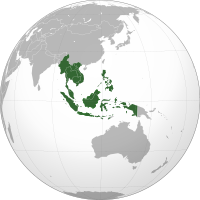
Photo from wikipedia
Abstract Economic growth, accompanied by rising energy demand in ASEAN countries have been unprecedented over these few years. On the other hand, the energy consumed in the ASEAN region is… Click to show full abstract
Abstract Economic growth, accompanied by rising energy demand in ASEAN countries have been unprecedented over these few years. On the other hand, the energy consumed in the ASEAN region is predominantly non-renewable, which could have implications for sustainable development. Previous studies that have investigated the energy-growth-environment nexus for this region are inefficient in terms of the proxies used to measure environmental quality and the estimation techniques adopted. As such this study explores the influence of renewable and non-renewable energy consumption, economic growth, and urbanization on a more reliable environmental indicator (ecological footprint) from 1990 to 2016, while controlling for trade. First-and-second-generation unit root and cointegration tests are applied amidst evidence of cross-sectional dependence. Findings reveal that economic growth, trade, and non-renewable energy contribute significantly to environmental degradation in ASEAN countries. This suggests that the region is growing at the expense of its environment, while also indulging in emission-intensive trade. Further findings show a one-way causality from urbanization to non-renewable energy consumption. Policy directions and implications of the findings for sustainability are discussed.
Journal Title: Journal of Cleaner Production
Year Published: 2020
Link to full text (if available)
Share on Social Media: Sign Up to like & get
recommendations!